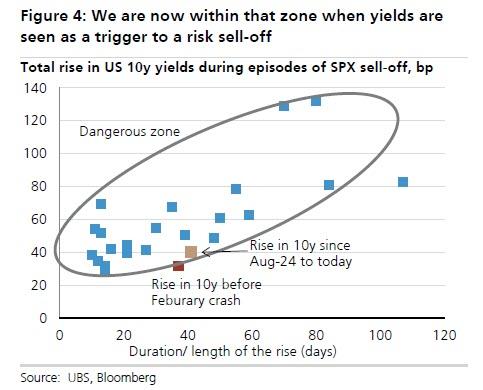In our earlier discussion of rising rates precipitating a drop in stocks, we noted that while the absolute level of the 10Y yield in itself is a key trigger to a selloff, the other catalyst is the speed/rate of the selloff in rates – i.e., the faster the yield rise, the more likely the adverse reaction for stocks – and as shown in the chart below the current surge in 10Y yields is now perilously similar in both size and speed to that observed just before the February 5th crash.

Addressing this issue, overnight Goldman released a report which, just like UBS, concluded that not only is the move in the yields relevant, but the “speed matters” just as much.
First, putting the recent move in context, Goldman notes that the 30 bps rise in bond yields represents a 1.7 standard deviation move relative to the past three years (the average 1-month change in 10-year US Treasury yields during the last three years equaled 3 bp, with a standard deviation of 17 bp; the current move matches the 1.7 standard deviation move in January of this year).

Of course, higher bond yields do not necessarily result in lower equity prices. As we have discussed in the past, and as UBS noted overnight, the speed of changes in bond yields often matters more for equities than the level.
And while equities typically post the strongest returns when bond yields are falling, historically they have also been able to digest gradually rising bond yields, as long as the rate of ascent is less than 1 standard deviation or 20 bp in today’s terms.
So is there a “threshold” level for the speed of rising yield beyond which stocks always selloff? As it turns out, there is, and as Goldman notes, S&P 500 returns have typically been negative in months where bond yields have risen by more than 2 standard deviations, to wit:
When bond yields have surged by 1-2 standard deviations in a month (~20-40 bp today), S&P 500 returns have typically been flat. When bond yields have risen by more than 2 standard deviations in a month (~40+ bp), S&P 500 returns have typically been negative (see Exhibit 3).









Leave A Comment